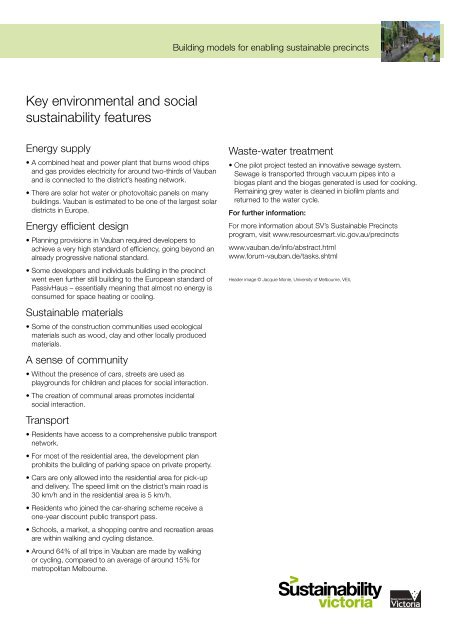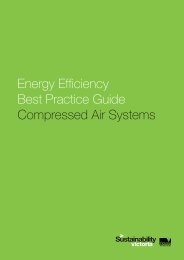Case Study: Vauban, Germany - ResourceSmart
Case Study: Vauban, Germany - ResourceSmart
Case Study: Vauban, Germany - ResourceSmart
Create successful ePaper yourself
Turn your PDF publications into a flip-book with our unique Google optimized e-Paper software.
Key environmental and social<br />
sustainability features<br />
Energy supply<br />
• A combined heat and power plant that burns wood chips<br />
and gas provides electricity for around two-thirds of <strong>Vauban</strong><br />
and is connected to the district’s heating network.<br />
• There are solar hot water or photovoltaic panels on many<br />
buildings. <strong>Vauban</strong> is estimated to be one of the largest solar<br />
districts in Europe.<br />
Energy efficient design<br />
• Planning provisions in <strong>Vauban</strong> required developers to<br />
achieve a very high standard of efficiency, going beyond an<br />
already progressive national standard.<br />
• Some developers and individuals building in the precinct<br />
went even further still building to the European standard of<br />
PassivHaus – essentially meaning that almost no energy is<br />
consumed for space heating or cooling.<br />
Sustainable materials<br />
• Some of the construction communities used ecological<br />
materials such as wood, clay and other locally produced<br />
materials.<br />
A sense of community<br />
• Without the presence of cars, streets are used as<br />
playgrounds for children and places for social interaction.<br />
• The creation of communal areas promotes incidental<br />
social interaction.<br />
Transport<br />
• Residents have access to a comprehensive public transport<br />
network.<br />
• For most of the residential area, the development plan<br />
prohibits the building of parking space on private property.<br />
• Cars are only allowed into the residential area for pick-up<br />
and delivery. The speed limit on the district’s main road is<br />
30 km/h and in the residential area is 5 km/h.<br />
• Residents who joined the car-sharing scheme receive a<br />
one-year discount public transport pass.<br />
• Schools, a market, a shopping centre and recreation areas<br />
are within walking and cycling distance.<br />
• Around 64% of all trips in <strong>Vauban</strong> are made by walking<br />
or cycling, compared to an average of around 15% for<br />
metropolitan Melbourne.<br />
Building models for enabling sustainable precincts<br />
Waste-water treatment<br />
• One pilot project tested an innovative sewage system.<br />
Sewage is transported through vacuum pipes into a<br />
biogas plant and the biogas generated is used for cooking.<br />
Remaining grey water is cleaned in biofilm plants and<br />
returned to the water cycle.<br />
For further information:<br />
For more information about SV’s Sustainable Precincts<br />
program, visit www.resourcesmart.vic.gov.au/precincts<br />
www.vauban.de/info/abstract.html<br />
www.forum-vauban.de/tasks.shtml<br />
Header image © Jacquie Monie, University of Melbourne, VEIL



